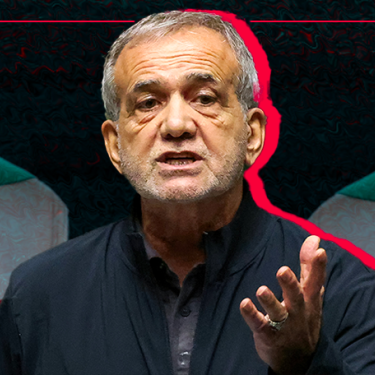Iran: the persecution of journalists continues despite new president’s promise

Last August, the Iranian president agreed to ask government agencies to withdraw complaints against journalists. Yet the persecution continues: Reporters Without Borders (RSF) has documented four cases of legal intimidation against seven journalists since the president’s mandate began. This repression must end.
Good news is rare for Iran’s journalists, but on 7 August – the day preceding Iran’s National Journalist’s Day – a positive development brightened the horizon. President Masoud Pezeshkian, successor to the late Ebrahim Raisi as of 28 July, agreed to issue a decree for government institutions to withdraw their complaints against journalists. The Association of Iranian Journalists, the syndicate that proposed the initiative, was encouraged by the president’s reformist views during his election campaign. “Several judicial complaints have been filed by government officials and institutions against journalists in the past year," the syndicate’s letter read. “Although no accurate assessment exists of their number, it seems high, and a large number of journalists are caught in court cases, fines and imprisonment.”
Although the president agreed, and issued a decree for the government to withdraw these complaints, only three ministries announced their compliance, and the persecution of reporters continued. According to RSF’s information:
- On 12 August, the Iranian Cyber Police (FATA) interrogated journalist Fatemeh Gholipour Ganjalou, from Rokna news website about her coverage of an attack on a religious procession in Tabriz, northwest of Iran. The journalist was also summoned by the prosecutor in Tabriz on 12, 17, and 19 August, and was reminded not to question police actions on security matters.
- On 11 August, a Karaj court handed journalist Omid Faraghat a six-month prison sentence and a two-year ban on publishing, accusing him of “propaganda.” Faraghat had been arrested on 2 March due to his work, and was released on bail a few hours later.
- On 25 August, the Iranshahr University of Medical Sciences, a public institution, filed a complaint against journalists Sheyda Hassan Zahi and Mohamad Yasin Jalal Zahi from the Mayarjal news website that covers the southeast of Iran, claiming their report on service issues in the hospital’s dialysis department spread “false and insulting information.”
“The fragile hope sparked by President Pezeshkian’s decision in August was short-lived. The persecution of journalists in Iran – their arrest, interrogation, sentencing, and intimidation – continues undisturbed. As we approach the second anniversary of the Woman, Life, Freedom protests, we call for the liberation of all all 25 journalists currently imprisoned in Iran – 16 of whom were imprisoned since the 2022 protests – and an end to the legal harassment of reporters. The president should ensure his request is respected, and that it extends to all authorities and agencies in Iran, without exception.”
Limited presidential authority
President Pezeshkian’s decision extends only to the government agencies under his authority. As head of the executive branch, he oversees several institutions, including the cabinets and ministries, the Supreme National Security Council, and the Atomic Energy Organization of Iran, among others. Yet despite his significant influence, political power in Iran ultimately resides with the Islamic Republic's Supreme Leader Ayatollah Khamenei, who controls the military, judiciary and other key institutions unconcerned by the president’s “promise.” For instance, the Tabriz prosecutor’s office, which summoned Ganjalou, and the Karaj court, which sentenced Faraghad, do not fall within the president’s authority.
In fact, the president’s decision on 7 August was issued just hours after a a court in the province of Abadan summoned freelance journalists Mandana Sadeghi, Arash Ghaleh Golab, and Kourosh Karampour in connection to their coverage of the Woman, Life, Freedom protests two years prior. They were released on bail a few hours later and currently await the court’s decision.
More than 100 journalists have been interrogated, detained, or imprisoned since the start of the protest movement sparked on September 16, 2022 following the death of Kurdish student Mahsa Amini in police custody in Tehran. Sixteen of them remain in prison to this day due to their work, alongside 19 other journalists who were imprisoned before the protests began.
